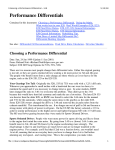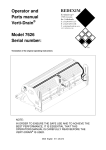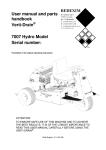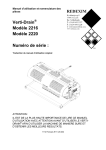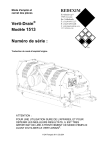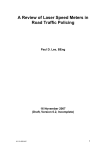Download Verti-Drain 7110 - Charterhouse Turf Machinery
Transcript
User manual and parts handbook Verti-Drain® Model 7110 Serial number: Translation of the original operating instructions ATTENTION: TO ENSURE SAFE USE OF THIS MACHINE AND TO BE ABLE TO ACHIEVE THE BEST RESULTS, IT IS OF THE UTMOST IMPORTANCE TO READ THIS USER MANUAL THOROUGHLY BEFORE USING THE VERTI-DRAIN®. 0948 English 911.120.473 FOREWORD Congratulations on your purchase of the Verti-Drain®. To ensure the long and safe use of ® this Verti-Drain , it is of the utmost importance for all those who will be using it to read and understand this user manual. Operation of this machine is not safe without full knowledge of the content of the manual. ® The Verti-Drain is not an independently operating machine. The user is responsible for ® using the appropriate tractor. The user must also check the tractor/Verti-Drain combination for safety aspects such as the noise level, adequate user instructions, and possible risk factors. ® The Verti-Drain is solely intended for use on lawns and other areas where grass could grow. On the next page you will first find the general safety instructions. Every user must know and apply them. After this, a registration card is included. This card should be returned for handling any future claims. This user manual offers many instructions numbered in sequence. This sequence should be observed. An asterisk * indicates a safety instruction. An @ indicates a tip and/or note. All information and technical specifications provided at the moment that this document is published are the most recent ones. Design specifications may be changed without prior notice. This document is a translation of the original operating instructions. Upon request, the original operating instructions are available in Dutch. GUARANTEE CONDITIONS ® THIS VERTI-DRAIN IS DELIVERED WITH A WARRANTY AGAINST DEFECTS IN MATERIALS. THIS GUARANTEE IS VALID FOR A PERIOD OF 12 MONTHS FROM THE PURCHASING DATE. VERTI-DRAIN® WARRANTIES ARE SUBJECT TO THE “GENERAL CONDITIONS FOR SUPPLY OF PLANT AND MACHINERY FOR EXPORT, NUMBER 188”, WHICH ARE PUBLISHED UNDER THE AUSPICES OF THE UNITED NATIONS ECONOMIC COMMISSION FOR EUROPE. REGISTRATION CARD For your own information, please complete the table below: Serial number of machine Dealer name Purchasing date Remarks 2 ! SAFETY INSTRUCTIONS ! The design of the Verti-Drain® allows for safe use. However, this is only possible if the user fully observes the safety instructions given in this manual. Read and understand (Fig. 1) the manual before starting to use the Verti-Drain. If the machine is not used as described in the manual, injury and/or damage to the Verti-Drain® may result. ` Fig. 1 (1) The Verti-Drain® is solely intended for the treatment of lawns or other areas where grass should grow. Any other use is considered to be incorrect use. The manufacturer accepts no liability whatsoever with regard to damage resulting from such incorrect use; all resulting risks are the responsibility of the user. Correct use also includes following the manufacturer’s usage, maintenance and repair instructions. Before using the Verti-Drain®, inspect the area to be treated. Remove any loose obstacles and avoid irregularities. The Verti-Drain® was constructed according to the latest technological knowledge and is safe to use. Improper use, maintenance or repair of the machine may result in injury to both the user and others. This should be avoided! ® Always use the Verti-Drain in combination with the proper tractor as described in the technical data. (3) All persons whom the owner assigns to operate, maintain or repair the Verti-Drain® must read and have completely understood the operating manual and in particular the section Safety Instructions. The user is responsible for a safe tractor/ Verti Drain® combination. This unit must be tested in terms of noise, safety and ease-of-use. In addition, user’s instructions must be prepared. (4) The user is obliged, before using the Verti-Drain®, to check it for visible damage and defects. ® Any changes in the Verti-Drain (including its functioning) that may affect its safety must be corrected immediately. For reasons of safety, any modifications or additions to the Verti-Drain® (with the exception of those approved by the manufacturer) are not permitted in principle. If any modifications have been made to the Verti-Drain®, the present CE certificate becomes null and void and the person who made the modifications should himself make sure a new CE certificate is granted. 3 Before each use, inspect the Verti-Drain® for loose bolts/nuts/parts. If present, inspect the hydraulic hoses regularly and replace them if they are damaged or show signs of wear. The replacement hoses must meet the manufacturer’s technical specifications. Always relieve the pressure from the hydraulic installation, if present, before carrying out any work on it. ® NEVER use de Verti-Drain if its protective covers and safety decals are missing. NEVER crawl underneath the Verti-Drain®. If you need to access the bottom, tilt the Verti-Drain®. NEVER step off the tractor while the engine is still running. When carrying out maintenance, adjustments or repairs, make sure the VertiDrain® is blocked from sagging/moving/sliding. Before carrying out any maintenance, adjustments or repairs, always switch off the tractor engine first, remove the tractor key from the ignition, and disconnect the PTO (Fig. 2). Fig. 2 When carrying out any maintenance or repairs, make sure to use original VertiDrain® parts only. This will ensure continued safety of the machine and its user. Only authorised technical personnel may carry out adjustments and repair work to the Verti-Drain®. Keep an overview of repairs. (5) Besides the instructions in this user manual, the generally applicable safety and Occupational Health and Safety Act instructions must also be followed. For use on public roads the relevant traffic rules also apply. Transporting persons is not permitted! Do not use the Verti-Drain® when it is dark, during heavy rain/ storms, or on slopes with a gradient greater than 20 degrees. 4 (6) Before embarking on any job, all persons operating the Verti-Drain® must be familiar with its functions and operating elements. ® Connect the Verti-Drain to the vehicle that will pull it exactly according to the instructions (Danger of injury!) Before driving off, make sure you have a clear view both nearby and far away. On both sides of the Verti-Drain® on the sideboard, there are safety stickers (Fig. 3,4,5) and on the back cover (Fig. 6) with the same meaning. Make sure these safety stickers are always clearly visible and legible. Replace them if they are damaged. During operation, make sure there are NO persons in the danger area of the Verti-Drain®, because they may be injured by moving parts. (Fig. 3). Fig. 4 Fig. 3 Remain at least 4 metres away! (Fig. 4). The back cover must always be closed and undamaged during operation of the machine! (Fig. 5). Be careful not to get pinched when opening the rear cover! (Fig. 6). Fig. 5 Fig. 6 Be aware of the maximum lifting capacity of the towing vehicle. Wear suitable clothing. Wear sturdy shoes with a steel cap, long trousers, tie up long hair and do not wear loose clothing. 5 (7) Location of safety stickers. (Fig. 7). Fig. 7 Used oil/grease is harmful to the environment; dispose of it according to locally applicable regulations. 6 CONTENTS Section Description Page Foreword 2 Guarantee conditions 2 Registration card 2 Safety instructions 3 1.0 Technical data 8 2.0 First installation, removing the machine from the pallet 9 3.0 General parts list 10 4.0 The power take-off shaft 11 4.1 The length of the power take-off shaft 11 4.2 Use of the power take-off shaft 12 5.0 Adjusting the working depth 12 6.0 Pin angle adjustment 13 7.0 Driving speed 13 8.0 Start procedure 9.0 10.0 15 ® Operation of the Verti-Drain 15 ® Transportation of the Verti-Drain ® 16 11.0 Disconnecting the Verti-Drain 16 12.0 Troubleshooting 17 13.0 Maintenance 18 14.0 EU certificate 19 15.0 Technical information 20 15.1 The crankshaft 20 15.1.2 15.1.3 15.2 Replacement of a crank throw / crank bearing 21 Releasing crankshaft tension/torque values Aligning an element 21 21 15.3 Tensioning the V-belt drive 22 16.0 Options, Turf hold-down kit 23 16.1 Options, pins 24 16.1.1 Solid pins 24 16.1.2 Hollow pins 25 16.2 Windrow Kit 25 16.3 Back roller 26 Parts pages 7 1.0 TECHNICAL DATA Model 7110 Working width 1.0 m (40”) Working depth Up to 150 mm (6”) Tractor speed measured at 500 rpm PTO-shaft speed Hole separation 55 mm (2-1/8”) Hole separation 90 mm (3-1/2”) Hole separation 125 mm (5”) PTO-shaft speed: Up to 1,65 km/hr (1,03 mph) Up to 2,70 km/hr (1,68mph) Up to 3,75 km/hr (2,33mph) 500 rpm Weight 340 kg (750 lbs) Hole separation between the pins 55 mm (2-1/8”) Hole separation in driving direction 50 - 125 mm (2” - 5”) Recommended tractor 13 HP with minimum lifting capacity of 410 kg (943 lbs) Maximum capacity Hole separation 55 mm (2-1/8”) Hole separation 90 mm (3-1/2”) Hole separation125 mm (5”) Shipping dimensions Up to 1650 m²/hr (17760 ft²/hr) Up to 2700 m²/hr (29062 ft²/hr) Up to 3750 m²/hr (40365 ft²/hr) 1260 x 700 x 900 mm (49.6” x 27.6” x 35.4”) Maximum pin size Three-point connection Solid 12 x 150 mm (1/2”x 6”) Hollow 19 x 150 mm (3/4”x 6”) 3- point CAT 1 Gearbox oil SAE 140 Lubricant EP 2 Standard parts Set of solid pins 12x150 (1/2”x 6”). Front roller Tool tube with tools and user manual. PTO shaft. Adjustable legs. Options Solid pins Hollow pins Turf hold down fingers Windrow kit Back roller 8 2 1 3 4 Fig. 8 2.0 FIRST INSTALLATION, REMOVING THE MACHINE FROM THE PALLET The machine is standing vertically on the pallet. To remove the pallet and lay the machine horizontally, carry out the following steps (see fig. 8): 1. Open the rear cover 2. Remove the PTO, PTO protective cover, pins and adjustable legs 1 from the machine. 3. Fit adjustable legs 1 and lock them with the retaining clip supplied. 4. Fasten a cable to the lifting point * Make sure that the cable/crane/lift can lift at least 410 kg (943 lbs). @ Be careful that no machine parts can be bent by lifting! 5. Use the pallet to lift the machine from the ground and place it on the adjustable legs. 6. Remove the pallet by sliding it from the lower 3-point pins * Do not crawl under the machine!! 7. Install the included PTO cover 2. 8. Attach the machine to a tractor. * Use the correct tractor. See the specifications. @ If the bottom 3-point connecting arms of the tractor cannot get to the connecting pins, there is the possibility of inserting it in another hole 4. 9. Place the machine on the ground, and turn the top rod to adjust the angle of the machine to 90 degrees. @ this angle of 90 degrees is very important for the correct operation of the machine. 10. Set the tractor’s stabiliser to 50 mm of lateral movement. 11. Mount the pins. Grease the end that will be inserted. 12. Length of the PTO shaft, see 3.1. 9 4 8 1 9 10 11 5 12 7 6 2 3 11 Fig. 9 3.0 GENERAL PARTS LIST Figure 9 shows some important parts: 1. Safety decal RA, read user manual before use / Toolbox with tools and manual. 2. Safety sticker 911.280.402: keep a distance of at least 4 metres from the machine. Stop the engine before carrying out repairs or adjustments. 3. Safety decal 911.280.404, the back cover must always be closed and undamaged during operation of the machine! 4. Safety decal 900.280.404, Be careful not to get pinched when opening the rear cover! * Make sure all decals are clearly visible on the machine and are understood. 5. The serial number is on the inside of the machine. 6. Operating-depth indicator. Attention: the indication is based on the maximum length of the pins. 7. Pin angle adjustment handle/indicator. 8. Three-point fastening pins. 9. PTO protective cover on the machine. 10. PTO input shaft. 11. Star button/nut for securing the back cover of the Verti-Drain®. 12. Storage legs 10 4.0 The PTO shaft Ma x. 3 0° A Ma x. 3 0° The PTO shaft is a very important part. It provides the driving force from the tractor and – if installed, used, and maintained correctly – ensures safe use of the machine. The PTO shaft has its own CE certificate. Make sure to read the PTO shaft manual. It is located on the PTO shaft itself. B 150m m (6" ) min. Fig. 10 4.1 LENGTH OF THE PTO SHAFT The length of the PTO shaft is very important. If it is too long, it may damage the drive of the tractor and/or the Verti-Drain®. If the overlapping length of the sleeves is, at any time, shorter than 150 mm, the PTO shaft may be damaged. *The length will vary when the machine is raised or if another tractor is used. To make sure the length of the PTO shaft is correct, after purchase or when using another tractor, carry out the following steps: (see Fig.10) 1. Measure the distance between the PTO connection of the tractor and that of the VertiDrain, from groove to groove, when the machine is at the correct angle on the ground and attached to the tractor. 2. Measure the distance B of the PTO at its shortest position, from locking pin to locking bolt. 3. Split the PTO in two and remove the protective cover from both ends. 4. Both the sleeve ends and the cover ends have to be shortened: (B-A) + 75 mm (3”). 5. Debur, grease, and assemble all parts. 6. Mount the PTO on the Verti-Drain side. 7. Attach the other end of the PTO to the tractor. 8. Check the overlap of the sleeves. *Never use the machine if the protective cover of the PTO is damaged. Replace it first. 11 4.2 OPERATION OF THE PTO SHAFT To ensure correct operation of the PTO, check the following items: 1. During operation, the angle of the joints must never be greater than 30 degrees. 2. The rotating points should be aligned. 3. The overlap of the sleeves must be at least 150 mm. 4. Never use the machine if the protective cover of the PTO is damaged. 5. For lubrication, see section 13.0: Maintenance. 3 1 1 3 3 2 1 2 F Fig. 11 Fig. 12 5.0 OPERATING-DEPTH ADJUSTMENT The operating depth can be adjusted when the machine is lifted, see fig. 11. Loosen nuts 1 one turn on both sides of the machine. Then turn bolt 3 in or out. Each rotation is 4 mm (0.160”). Label 2 on the side of the machine indicates the depth setting. After having reached the correct working depth, retighten nuts 1. @ Never adjust one side more than 4 turns. Before continuing, compensate the other side. @ A spanner is included in the machine’s tool tube. @ The depth-adjustment on the decals only applies when 150 mm (6”) long pins are used. When shorter pins are used, subtract the difference in length, compared to 150 mm (6”), from the value shown on the decals. @ The spindle and the nut must be cleaned every 100 hours and sprayed with thin oil that does not attract dirt, to prevent dirt from remaining on the nut. 12 6.0 PIN ANGLE ADJUSTMENT All pins can be simultaneously adjusted with a centrally-placed handle, located on the side of the machine, see fig. 12. Lift the machine above the ground and loosen nut 2 on both sides of the machine. Adjust the angle by turning the handle. The angle can be read on the sticker. Retighten the nuts. @ @ @ @ An angle of 90 degrees means almost no draught. This is required for hollow pins and is advised for the needle pins. From 90 to 75 degrees means more draught. This is advised for solid pins and depends on the ground conditions, the pin size and the client’s preference. At 90 degrees, the pins only go straight into the ground if the machine is correctly installed, see fig. 1. If this is not correct, force F can be produced, see fig. 12, which will damage the machine. The length of the assembled drawbar must be 291 mm (11.5”), which can be calibrated using shims, see parts page. 7.0 DRIVING SPEED The hole distance D, fig. 13, in the driving direction is determined by the drive speed. The Verti-Drain® does not require creep gear. If the client wants a small hole distance, however, it must be possible to ride slowly enough, which depends on the tractor. The input speed of the PTO shaft R may not exceed 500 rpm. If hard objects can be expected, this speed must be reduced. With heavier pins, other applications, or with maximum pin angle, the pin holders may float. In this case, reduce the speed R before the pin holders are forced upward. Fig. 13 contains a table that shows the relationship between the driving speed and the hole distance. If the driving speed of the tractor for 500 revolutions of the PTO shaft is known, the hole distance can be determined. ® @ If the Verti-Drain is not correctly attached behind the tractor, see fig. 8, various PTO shaft angles can cause vibrations in the driveline of the machine. These vibrations can damage the machine and the holes in the ground. @ If the PTO shaft was shortened incorrectly, or if another tractor was used, the gearbox may be overloaded. Damage can occur. 13 Fig. 13 Fig. 14 14 8.0 START PROCEDURE The start procedure is VERY important. If this procedure is not followed exactly as described below, serious damage may occur to the machine. The start procedure is as follows, see fig. 14. 1. 2. 3. 4. 5. 6. Drive to the place where you want to start. Lower the machine until the lowest knives are almost touching the ground. Set the tractor motor at approximately 1200 rpm. Shift the tractor to the correct gear and drive forward (A). Engage the PTO shaft (B). While DRIVING forward, let the TURNING machine CAREFULLY sink into the ground (C).7. Increase the PTO shaft speed to the maximum allowable speed. Stopping is done as follows: 1. Decrease the motor speed to approximately 1200 rpm. Raise the machine out of the ground 3. Disengage the PTO shaft as soon as the pins are out of the ground. 4. Raise the machine further until the pins are at least 120 mm above the ground. 5. Go to the following place and start again as described. @ It is absolutely imperative that the above procedures are followed. If the placed in the ground first, without a rotating PTO shaft, serious machine can occur. @ The machine must be lowered CAREFULLY. @ Be careful when driving in reverse. machine is damage to the While working, the front roller must be in stable contact with the ground. If the machine is unstable, other pins must be installed or the operating depth must be adjusted. @ The machine will be damaged if the instability is not corrected. The machine does NOT have protection against long-duration overloading. @ NEVER drive in reverse with the pins in, or close to, the ground. @ Do not use a hydraulic top rod. ` 9.0 OPERATION OF THE VERTI-DRAIN® Before the Verti-Drain® is used in the field, the following should be checked: 1. Are there any loose objects in the field? Remove these first. 2. Are there any slopes? The maximum slope this machine can work on is 20 degrees. Always work downhill. 3. Does the ground contain cables or pipes? If so, determine their depth and set the operating depth of the machine to 60% of this depth. ® 4. Does the ground contain hard objects? If so, use the Verti-Drain at a low PTO shaft speed and adjust the operating depth. 5. Is there any danger of flying objects, such as golf balls, which may distract the attention of the driver? If so, do NOT use the Verti-Drain®. 6. Is there any danger of sinking or sliding away? If so, postpone working with the VertiDrain®. 7. If the soil is frozen or very wet, the work should be postponed until the conditions are more favourable. 8. When the soil is very compact, use shorter pins or adjust the operating depth. 15 10.0 TRANSPORT OF THE VERTI-DRAIN® ® The user is responsible for the transport of the Verti-Drain behind the tractor when travelling on public roads. Check the national traffic regulations. On open fields, a maximum speed of 12 km/h (8 mph) should be observed, because of the weight of the Verti-Drain®. A higher speed may endanger the driver and/or other people and may even damage the machine. * When the machine is in the raised position, at least 20% of the weight of the tractor should be supported by the front axle. 1 Fig. 15 11.0 DISCONNECTING THE VERTI-DRAIN® The machine can be disconnected from the tractor as follows: (see fig. 15) 1. * Check the ground where the machine is to be disconnected; this must be firm and flat. The machine may not be able to sink/move on its own. 2. Turn adjustable legs 1 downwards and block them with the R-clips. 3. Carefully lower the machine onto the adjustable legs. 4. Lock the machine to prevent it from moving. 5. Remove the top rod. 6. Remove the PTO shaft on the tractor side. 7. Remove the lower arms from the Verti-Drain®. * Set the tractor motor off if people are walking around the machine and prevent the tractor from moving! 16 12.0 TROUBLESHOOTING Problem Machine vibrates Possible cause Crankshaft turns irregularly Heavy conditions Solid/hollow pins should be bent/broken. Wrong pin Heavy conditions Rapid wear Front roller is not in stable contact with the ground. Wrong pins, too much resistance Heavy conditions PTO breaks. Tubes split Damage to the drawbars. Bend / break Damage to the turf. Oval holes Damage to the turf Pin not secure in pin holder. Heavy conditions Crankshaft problems. Big-end nuts come loose Solution Machine not at 90 degrees. Angles of the PTO joints are different. Joints of PTO are not in line. Adjust the operating depth. Use thinner/shorter pins. If conditions are dry, water soil. Change the pin, use shorter pin. Use solid pins before hollow pins to break up the ground. Adjust the operating depth. Use thinner/shorter pins. If conditions are dry, water soil. First use solid pins to break open the ground. Adjust the pin angle. Change pin size. Adjust the operating depth accordingly. Use different pin size. Adjust the operating depth. Water the soil. PTO angles are too large. PTO angles are not the same. Machine not at 90 degrees. Centre bar bent. Bearing tubes worn. Pins touch the ground when driving in reverse. Lift height not correct. Ground too wet. Change pin angle adjustment. Reduce forward speed. Adjust the operating depth. Use thinner pins. Use different pins. Grind a flat area on the pins. Adjust the pin angle. Eliminate the vibration, see vibration. Crankshaft bearing worn. Incorrectly installed after repair. Remove, clean, use Loctite. 17 V-belts are slipping. Hole distances not equal V-belt tension too low V-belts are worn V-belt tension too low V-belts are worn Adjust the V-belt tension (see section 15.3). Replace V-belts. Adjust the V-belt tension (see section 15.3). Replace V-belts. 13.0 MAINTENANCE Time schedule Before each use After first 20 operating hours (new or repaired) Check point/lubricating point Method Check for loose bolts/nuts. Tighten the loose bolts/nuts with the correct torque. Connect the machine to the tractor and leave the machine running without load for five minutes. Look and listen for any strange noises and movements. Check the oil level in the gearbox. If necessary, use SAE 140 Presence and legibility of safety stickers (Fig. 7). Replace if damaged or missing. Any loose parts around the PTO. Secure these parts so that they cannot come too close to the PTO. Lubricate the PTO and roller . Use EP 2 lubricating grease. Check for loose bolts/nuts. Tighten the loose bolts/nuts with the correct torque. Connect the machine to the tractor and leave the machine running without load for five minutes. Look and listen for any strange noises and movements. Check the oil level in the gearbox. The oil level should be Use SAE 140 at the centre of the gauge glass. Check the transmission for oil leaks. Replace seals / sealing paste. 18 Time schedule After first 20 operating hours Check point/lubricating point Any loose parts around the PTO. Secure these parts so that they cannot come too close to the PTO. Check V-belt tension Adjust the V-belt tension (see section 15.3) Use EP 2 lubricating grease. (new or repaired) After every 50 operating hours. Method Lubricate the PTO and roller bearings. Check for loose bolts/nuts. Tighten the loose bolts/nuts with the correct torque. Connect the machine to the tractor and leave the machine running without load for five minutes. Look and listen for any strange noises and movements. Replace the oil in the gearbox. Use SAE 140 Check the transmission for oil leaks. Replace seals / sealing paste. Check the V-belt tension. After every 500 operating hours. Replace the oil in the gearbox. Adjust the tension if necessary. Use SAE 140 14.0 EU DECLARATION OF CONFORMITY We, Redexim, Utrechtseweg 127, 3702 AC Zeist, The Netherlands, declare entirely on our own responsibility that the product: VERTI-DRAIN® MODEL 7110, WITH MACHINE NUMBER AS INDICATED ON THE MACHINE AND IN THIS MANUAL, to which this declaration relates is according to the stipulation of the 2006/42/EC directive for machines. Zeist, 01/10/09 A.C. Bos Manager Operations & Logistics Redexim Holland 19 15.0 TECHNICAL INFORMATION 6 5 4 7 3 2 1 Fig. 16 15.1 THE CRANKSHAFT The crankshaft assembly is shown in figure 16. A more detailed drawing can be found on the parts page. For a 7110, the offset between the crankshaft throws in the gearbox must be 60 degrees. 15.1.2. REPLACEMENT OF A CRANK THROW / CRANK BEARING Replacement of a crankshaft throw is necessary when it is cracked or when the nuts regularly come loose from the big-end. That is, if the throw bearings, the throw-bearing fittings, or the big-end pin holes in the throw are damaged. Replace the throw / the bearing as soon as possible, to prevent additional damage to other parts, as follows (see fig. 16): 1. Remove Big-End 2 2. Remove handles 3. 3. Remove profile shaft 4 with bearing 5. 4. Remove bearing 5 from profile shaft 4. 5. Replace the parts and assemble in the reverse order. @ Use Loctite for nuts 6 and 7 20 15.1.3 Releasing crankshaft tension If parts of the crankshaft have been replaced, the crankshaft may be more difficult to turn. Pre-tension can be the cause. It is necessary to eliminate the sources of tension as follows, see fig. 16: 1. Use a hammer to tap against the centre of the throw, starting with throw 1 located next to the V-belt drive. 2. Feel whether the throw moves in the bearing and continue until the throw settles into place. 3. Repeat this procedure for each adjacent throw until all of the throws have settled into position and the crankshaft turns more easily. @ After repairing the crankshaft, the nuts must be checked regularly for looseness. @ Do not mount the throws on the wrong side of the machine. See the parts page for the correct part numbers. Timing Starting Reference Element 1 2 5 4 1 1 6 3 2 3 4 Element 1 Element 2 Element 3 Element 4 Element 5 Element 6 5 0 degrees 3.00 h 120 degrees 11.00 h 240 degrees 7.00 h 180 degrees 9.00 h 60 degrees 1.00 h 300 degrees 5.00 h 6 800Nm (590 lbf.ft.) !!Lock washer!! 800Nm (59 lbf.ft.) A 100Nm (73.8 lbf.ft.) B 100Nm (73.8 lbf.ft.) 100Nm (73.8 lbf.ft.) 80 Nm (59 lbf.ft.) 100 Nm (73.8 lbf.ft.) 100 Nm (73.8 lbf.ft.) 80 Nm (59 lbf.ft.) 40 Nm (29.5 lbf.ft.) !!Lock all Bolts/Nuts with Loctite!! Fig. 17 15.2 ALIGNING AN ELEMENT. If an element is no longer in line with the adjacent elements, the alignment can be corrected as follows: (See fig. 17) - Loosen the four bolts/nuts A, that connect the crankshaft to the element. - Loosen the two bolts B, with which the element is connected to the frame. - Try to align the element by moving it sideways until it is in line with the adjacent elements. Re-tighten all the bolts and nuts. - @ The element can be pushed out of alignment through overloading. @ Always realign an element whenever a throw is replaced so no extra tension is created in the total element assembly. @ Every pre-tension in the element assembly will reduce the life of the bearing and can also damage other parts. 21 15.3 TENSIONING THE V-BELT DRIVE. 2 1 3 A Fig. 18 If the Verti-Drain machine does not function properly and stands still with the pins in the ground while the transmission is driven, it is possible that the V-belt pre-tension must be adjusted. This works as follows, see Fig. 18: 1. Remove safety cover 2 by unscrewing nuts 2. 2. Unscrew the nut on tensioning pulley 3 and move the pulley downwards until the correct pre-tension is reached. 3. Tighten the nut on pulley 3 well. 4. Check the V-belt tension by hanging a mass of 2.5 kg (5.5 lbs) on point A. The extension must be 2 mm. 5. Place safety cover 2 and tighten nuts 1. 22 16.0 OPTIONS, TURF HOLD-DOWN KIT. 3 1 2 Fig. 19 You can use a turf hold-down kit when the turf layer comes loose. A Turf Hold Down Kit can be supplied for the 12 mm pins under number 211.710.002. The Verti-Drain 7110 is equipped standard with a pre-mounted main beam on which the turf hold-down fingers can be mounted. The kit consists of a set of turf hold-down fingers for 12 mm pins and the mounting material, consisting of a number of bolts and nuts. INSTALLATION OF THE TURF HOLD-DOWN KIT (see fig. 18): - The ordered set comes with plates 2. Fasten the plates to the main beam with bolt 3 and nut 1. Align the plates with the pins through the slotted holes in the plates. - When the plates have been in use for some time and are bent in one direction, reverse their direction. OTHER SUGGESTIONS: - When the pins no longer sit in the middle of the machine, they may contact the sides of the slots. Re-align the pin blocks. - If the pins contact the front side of the hole (during use), check the length of the drawbar. Never crawl under the machine. Make sure the machine is properly blocked! 23 16.1 OPTIONS, PINS Pins are essential for the correct operation of the machine. There are various pins available for this machine; see the parts page for a complete overview. In general, the pins can be divided into two categories: solid and hollow pins. We advise you to use only original pins because they are completely adapted to the machine. The pin holders have 3 x 12 mm (½”) holes in which pins can be secured. Locking bolt A may be tightened to 40 Nm (29.5 lbf.ft.). (Fig. 20) If the pins come out of the pin holders, grind a flat area on the mounting end of the pins. 16.1.1 SOLID PINS. Solid pins break open compacted soil. The pin angle adjustment (see chapter 6.0) determines the quantity of draught movement in the ground. When the angle is adjusted from 90 to 75 degrees, the draught movement increases. With a 90 degree adjustment, there is almost no pin movement created in the ground. When the pins are new, they may damage the turf, in particular when the root system is weak. First clean the pins manually or use the machine first for 10 minutes on another rough ground surface. When the root system is weak, try to adjust the working depth such that the pricking depth is slightly deeper than the length of the roots. This gives the roots a chance to grow deeper. Prick deeper the next time. By using this method, you can prevent damage to the turf and ensure a healthy root system. We advise you to use the solid pins with the sharp point toward the front roller. This ensures the best pin movement into the ground. On the other hand, for weak turf, we advise you to use the pins with the sharp point toward the rear of the machine. A Fig. 20 24 Always use pins with the same diameter and length. Replace a bent pin immediately. If this is not done, the machine can become unstable. Do not use thicker and/or longer pins than we supply. Shorter (ground off) pins can be used when shallower pricking is desired. Be aware that the operating depth indicated on the decal is only accurate when the maximum length of the pin is used. When oval holes are created, this means that there is a weak top layer with a hard layer underneath. Use thinner pins or wait until the (wet) top layer has dried. When top dressing must be applied, apply it before using the Verti-Drain. When the ground is difficult to prick, water the soil first, use thinner and shorter pins, or adjust the operating depth. If these measures are not taken, the machine will eventually be damaged. 16.1.2 HOLLOW PINS The ground can be mixed with hollow pins. Various sizes are available; see the parts page for more information. The opening of the pin must be directed toward the rear of the machine. For hollow pins it is important that the pin angle is set to 90 degrees. The movement of the pin in the ground is minimal and in this manner a nice “clean” hole is made. When the pin continuously moves in the ground at an angle less than 90 degrees, the pin may eventually break. When top dressing must be applied, use the Verti-Drain first, remove the “cores” and then spread the sand. When lots of waste occurs while pricking with hollow pins, reduce the rotational speed or wet the soil first. The waste can increase the rate of wear to your machine. If the turf is damaged, first use solid pins to establish a healthy root system and then adjust the operating depth. When the hollow pins become plugged, this means that the ground is (very) compact and solid pins must be used first to break the ground open. Wetting the soil or adjusting the operating depth can also help solve this problem. 16.2 OPTIONS, WINDROW KIT If hollow pins are used to prick with, cores can be removed from the soil. The Windrow kit ensures that the cores are guided neatly together after the Verti-Drain operation, after which they can be easily removed. The kit can be supplied under number 211.710.006 25 16.3 OPTIONS, REAR ROLLER Fig. 21 The Verti-Drain is not fitted with a rear roller as standard. If desired, a rear roller can be supplied under number 211.710.004. The kit consists of a rear roller with adjustable scraper, and the fixing legs with assembly material for attachment to the Verti-Drain. 26


























